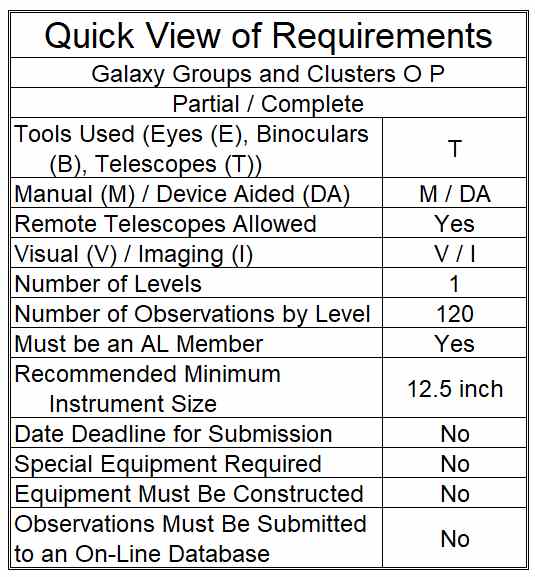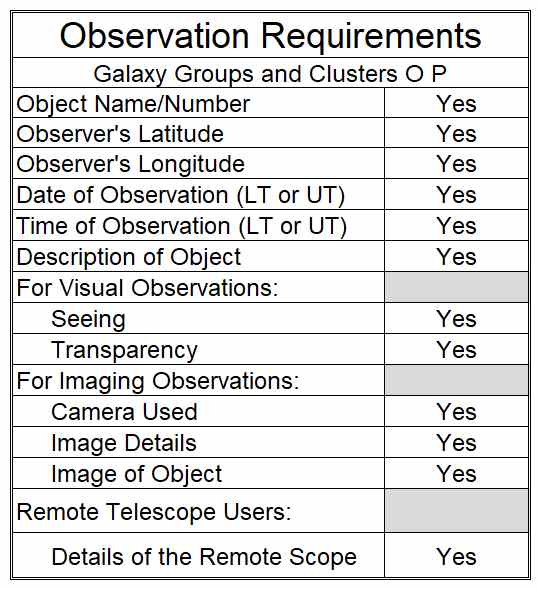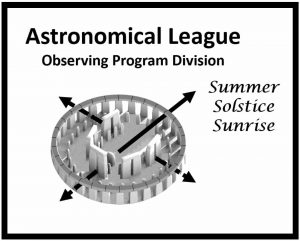Galaxy Groups and Clusters Program Coordinator:Russell F. Pinizzotto |
|
IntroductionWelcome to the Astronomical League’s Galaxy Groups and Clusters Observing Program. This program of 250 galaxy groups and clusters is designed for detailed visual observation or imaging. For many, the challenge will be to see these galaxy clusters with their own eyes. Most of the galaxy groups and clusters of this observing program are visually accessible with a 12.5″ telescope, although there are individual galaxies in some of the groups that are beyond almost all amateur observers. Although this Observing Program accommodates imagers, you don’t need a camera to complete this Observing Program. You will be able to see at least some galaxies in all of the groups. There are several rewards for undertaking this program, no matter which method you choose. Subtle visual detection will reward you with the thrilling experience of viewing extremely distant objects at the very edge of visibility. In an image, this same cluster may be a very beautiful cloud of galaxies and their dim clouds of globular clusters. |
 |
Learning to identify star fields is important even with a devide-aided telescope. An observer must match the galaxies with their map coordinates. Many of the clusters in this program’s catalog are dim and difficult objects to find, requiring the visual observer to starhop and use averted vision.
To obtain your certificate and pin for this Observing Program, purchase the Observe Galaxy Groups and Clusters observing guide, specifically written to support this observing program, from the AL Store .
The observing guide is for amateur astronomers who want to view or image galaxy groups and clusters visible in amateur telescopes. It contains a variety of associations from small compact groups, to larger, less compact groups (in some cases not well isolated from other nearby galaxies). Due to the nature of these complex objects, it is impossible to set a definite magnitude limit for this guide. In this sense, the challenge is open-ended. Try to observe as many galaxies as you can in each case and don’t be afraid to push your limits. You may be surprised to find that seemingly impossible faint objects will often yield to persistent scrutiny.
The observing guide includes a brief overview of some of the most popular atlases to assist you with their use and content. It also contains find a variety of helpful observing hints, techniques, coordinates, data and technical information.
Requirements and Rules
This certification is available to members of the Astronomical League, either through their local astronomical society or as members at large. If you are not a member and would like to become one, check with your local astronomical society, search for a local society on the Astronomical League Website, or join as a Member-At-Large at the AL Store
| There are two categories of search methods for this program, Manual and Device-Aided. To be considered for the Manual certificate, ALL of the objects must be found manually. A space is provided on the Submittal Form to indicate your search method.
Manual means that the observer hand-guides the telescope to the object. The observer uses his/her eye to see through the telescope to navigate to the object. Device-Aided means that the observer uses manual or digital setting circles, computer-controlled devices or other automatic aids in locating the object. There are also two types of observing techniques, visual and imaging. Visual means that the object is observed with the eye through the optics of the telescope. Imaging means that the observations are obtained using astrophotography or other imaging techniques. To qualify for the AL’s Galaxy Groups & Clusters certificate and pin, you need to be a member of the Astronomical League, either through an affiliated society or as a Member-At-Large. Of the 250 objects listed in the Galaxy Groups & Clusters Guide, you must observe 120 objects: 1) 30 Galaxy Trios; 2) 30 Hickson Compact Galaxy groups; 3) 30 Additional Galaxy Groups; and 4) 30 Abell Galaxy Clusters. Example forms for recording your observations ar eincluded in the observing guide. |
 |
Written object descriptions are required and include at a minimum:
- Date and Time (local time or Universal Time)
- Site (name site and include latitude, longitude and elevation)
- Seeing (describe on a scale; indicate which scale you are using)
- Transparency (give naked eye limiting magnitude or specify an alternate scale)
- Averted vision level if applicable (rate according to an averted vision scale)
- Instrument (include information on telescope, eyepieces, cameras or other instrumentation)
- Description, in your own words, of the group and individual galaxies as appropriate (in many cases you will probably only see a very faint smudge).
Complete an index by putting the page number of your descriptions next to the groups and clusters on the list. The check-off and date columns in the observing guide are for your own use.
Submitting for CertificationTo receive your Galaxy Groups & Clusters certificate and pin, complete the Submission form (found in the Guide, or equivalent) and submit it with a COPY of your observations to the Galaxy Groups and Clusters Observing Program Coordinator. Electronic submissions are encouraged. These may be submitted, or a link to images on the internet is acceptable. Be sure to include: your name, mailing address, email address, phone number, society affiliation, and to whom the certification should be sent. Galaxy Groups and Clusters Program Coordinator:Russell F. Pinizzotto |
 |
Notes:
- The Astronomical League Web Store has a great manual available with information for this Observing Program. It is available here.




